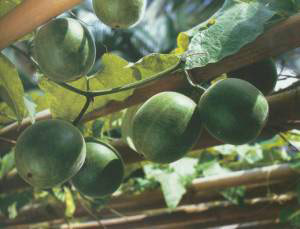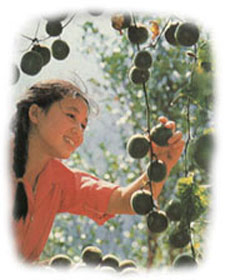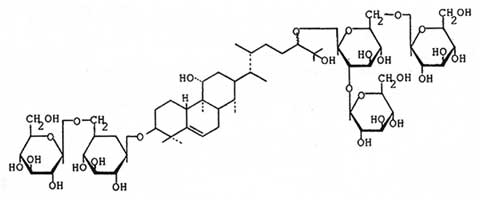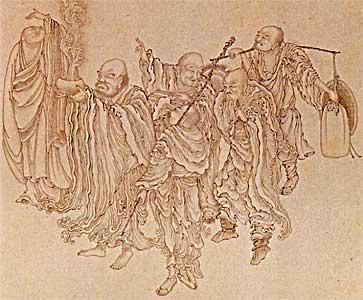 I'm resistant to doing away with Spl...
I'm resistant to doing away with Spl...  peace_thru_unity
17 y
7,874
peace_thru_unity
17 y
7,874
J.Crow’s® Lugol’s Iodine
Free S&H.Restore lost reserves.J.CROW’S®Lugol’s Iodine Solut...
Dr. Clark Shop
Hulda Clark Cleanses
MSG and Aspartame make me very, very ill, but I don't think I feel an ill effects from Splenda.
I have severe reactive hypoglycemia, so cannot eat *anything* with sugar, no matter what form the Sugar takes.
Carbohydrates -- potatoes, rice, pastas, breads -- make me ill in the same way as too much fruit at one time, candy, cake, icecream, etc....
people keep offering me "natural" Sugar in the form of fruit or carbs, and they don't understand that those things are still *sugar*
Can someone here tell me what's wrong with Splenda?
I have EBV with cfs/fibro/hypothyroid/IC, etc....
thanks!
peace
:)
More
- Re: I'm resistant to doing away with... #58143
17 y
7,646
MoreThis is a reply to # 897,275look in the the "news" forum, I think I saw a story there on splenda today.
- Re: I'm resistant to doing away with... #73736
17 y
7,198
J.Crow’s® Lugol’s Iodine
Free S&H.Restore lost reserves.J.CROW’S®Lugol’s Iodine Solut...
Dr. Clark Shop
Hulda Clark Cleanses
This is a reply to # 897,275the fact that it was first designed as ant poison kinda does it for me.
i use stevia now.- Re: I'm resistant to doing away with... peace_thru_unity
17 y
7,450
MoreThis is a reply to # 936,404yes, I read about that....
I stopped using Splenda about 2 weeks ago - we're using Xylitol now.
Haven't yet noticed any health effects, good or bad, from the switch.
:)
- Re: I'm resistant to doing away with... peace_thru_unity
17 y
7,450
- Splenda is bad news - Stevia and Lo ... Dquixote1217
17 y
7,761
This is a reply to # 897,275Advertisement
Hulda Clark Cleanses
Wormwood, Clove, Clarkia, Turmeric, Epsom Salt, Uva Ursi, Goldenrod
Take a look at:
http://www.mercola.com/2000/dec/3/sucralose_dangers.htm
and I doubt you will be a splenda user for long.
Among other things, the Mercola article reveals that:
- As of 2006, only six human trials have been published on Splenda (sucralose). Of these six trials, only two of the trials were completed and published before the FDA approved sucralose for human consumption. The two published trials had a grand total of 36 total human subjects.
- 36 people sure doesn't sound like many, but wait, it gets worse, only 23 total were actually given sucralose for testing and here is the real killer:
- The longest trial at this time had lasted only four days and looked at sucralose in relation to tooth decay, not human tolerance.
Stevia would be a good natural alternative. A better tasting, harder to find and more expensive alternative is Lo Han (also called Luo Han or Lo Huan). You can find it on the net, and, although it is pricey, you only use a tiny amount - since Lo Han is 200-250 time sweeter than sugar, which it tastes almost identical to.
DQ
- Re: Splenda is bad news - Stevia and... peace_thru_unity
17 y
7,390
-
 Luo Han Guo (Lo Han) Dquixote1217
17 y
12,647
This is a reply to # 937,228from http://www.itmonline.org/arts/luohanguo.htm
Luo Han Guo (Lo Han) Dquixote1217
17 y
12,647
This is a reply to # 937,228from http://www.itmonline.org/arts/luohanguo.htm
LUO HAN GUO
Sweet Fruit Used as Sugar Substitute and Medicinal Herb
Luo Han Guo (luohanguo) refers to the fruit of Siraitia grosvenori, formerly called Momordica grosvenori, a member of the Curcubitaceae (1). The fruit is well-known for its sweet taste; this plant family (Gourd family) has other members that contain remarkable sweet components, including additional species of the genus Siraitia (e.g., S. siamensis, S. silomaradjae, S. sikkimensis, S. africana, S. borneensis, and S. taiwaniana 2) and the popular herb jiaogulan (Gynostemma pentaphyllum). The latter herb, which has both sweet and bitter tasting triterpene glycosides in its leaves, is now sold worldwide as a tea and made into an extract for use in numerous health-care products (3). Luohanguo has been used as a medicinal herb for treating cough and sore throat (4) and is popularly considered, in southern China, to be a longevity aid (5). These are the same uses as listed for jiaogulan. Luohanguo has more recently been developed into a non-caloric sweetener to compete with other herbal sweeteners such stevioside from the unrelated Stevia leaf. (6).


Luohanguo is primarily grown in southern China, mainly in Guangxi Province, with most of the product from the mountains of Guilin. The steep mountains provide shade and they are frequently surrounded by mists that further protect against excessive sun, yet the temperature in this southern province is warm. The wild plant is rare, thus luohanguo has been cultivated in the region for many years. There are descriptions of its cultivation in the area dating back to 1813 (5). Guilin now has a 4,000-acre luohanguo growing area that produces 10,000 pieces of fruit annually (7). Most of these fields are in Yongfu and Lingui Counties, which are recognized in China as sites having an unusually high number of residents living to an age 100 years or more (8, 9), which some attribute to the consumption of luohanguo, as well as the pristine environment. However, the local residents mainly proclaim the benefits of tranquil lifestyle, simple diet, and regular exercise.
Longjiang Town (Dragon River) of Yongfu County was named "Home of Chinese luohanguo Fruits." Several factories have been established in this region to produce luohanguoluohanguo cultivation and its environs is offered by the Dragon River Company, a New York based international company that set-up manufacturing in the town of Dragon River. extracts and finished products, the oldest being the Yongfu Pharmaceuticals Factory. A carefully prepared visual presentation of

Luohanguo is collected as a round green fruit that turns brown upon drying. The sweet taste of luohanguo comes primarily from mogrosides, a group of terpene glycosides, present at the level of about 1% of the fleshy part of the fruit (10). Both the fresh and dried fruits are extracted to yield a powder that is 80% or more mogrosides. The mogrosides have been numbered, 1-5, and the main component is called mogroside-5, previously known as esgoside (see chemical structure diagram below). Other, similar compounds from luohanguo have been labeled siamenoside and neomogroside. The mixed mogrosides are estimated to be about 300 times as sweet as sugar by weight, so that the 80% extracts are nearly 250 times sweeter than sugar; pure mogrosides 4 and 5 may be 400 times as sweet as sugar by weight.

A process for making a useful sweetener from luohanguo was patented in 1995 by Procter and Gamble Company (2). As described in the patent application, the fruit itself, though sweet, has too many additional flavors that would make it unsuitable for widespread use as a sweetener, so P&G developed a method for processing it to eliminate the undesired flavors. The fruit is seldom used fresh anyway, due to the problems of storing it; further, the raw fruit has unattractive flavors and a tendency to easily form off-flavors by fermentation; also, its pectin eventually gels. So, it is common to dry the fruits for any further use, and this is how they appear in Chinese herb shops. The fruits are slowly dried in ovens; the drying process preserves the fruit and removes most of the objectionable flavor of the fresh fruit, which is associated with volatile components. Unfortunately, the drying also causes the formation of bitter, astringent flavors. These flavors limit the use of the dried fruits and dried fruit extracts to the preparation of dilute teas and soups and products to which sugar, honey, and the like are added. In the P&G process, the fresh fruit is picked before ripening and allowed to complete its ripening during storage so that processing begins with the just-ripe fruit. The peel and seeds are then removed, and the mashed fruit becomes the basis of a concentrated fruit juice or puree that can be used in food manufacturing. Further processing involves using solvents to remove volatile and off-flavor components. Numerous sugar substitutes derived from luohanguo by similar processes that isolate the sweet compounds are now readily available for manufacturing and for kitchen use.
HISTORY AND TRADITION

During the Tang Dynasty, Guilin was a major Buddhist retreat area with many temples. The fruit (guo, a term used mainly for gourd-like fruits) is named after the luohan, which are advanced Buddhist practitioners (see classic painting of some luohan, left; in India, they are called arhats) The story told in China is that knowledge of this fruit first emerged from monks who were using it during the 13th Century. Due to its limited natural growing area (mainly mountain sides in Guangxi and Guangdong; to a much lesser extent, in Guizhou, Hunan, Jiangxi, and Hainan Island), and difficulty in cultivating it successfully, this fruit did not enter the general herb tradition of China, which depended on more abundant products. So, it is not mentioned in the traditional herb guides (10).
The herb became more prominent during the 20th century. One early English-language report on it is an unpublished manuscript written in 1938 by Professor G.W. Groff and Hoh Hin Cheung (11). The fruits were reported to be frequently used as the main ingredient in cooling drinks (that is, drinks consumed to counteract hot weather, fever, or disorders described in the tradition as warm or hot in nature). The juice of fresh fruits was known to be very sweet. Groff and Hoh noted that the "luohan fruit of commerce, when cooked with pork or steeped with tea, provides a common Chinese household remedy for colds and congestion of the lungs." They confirmed through interviews that the fruit had only become extensively used in China in recent history. Still, it appears that the development of distinct cultivars, and extensive knowledge of its growth, pollination, and climatic requirements implies a fairly long history of cultivation activity by at least a limited group of people.
The herb had been brought to the U.S. early in the 20th century. Groff mentions that during a 1917 visit to the U.S. Department of Agriculture, botanist Frederick Coville showed him a luohan fruit obtained from a local Chinese store in Washington, DC.. Seeds from luohan fruits purchased in a San Francisco Chinese store were included in the original botanical description of the species in 1941.
The beginning of research into the sweet component of luohanguo is attributed to C.H. Lee, who published an English report in 1975 (12), and to Tsunematsu Takemoto working in Japan in the early 1980s (he later turned his attention to studying jiaogulan (3). Development of luohanguo products in China has grown steadily since that time, particularly with the more recent development of highly concentrated extracts for use as sweeteners.
Probably the best depiction of luohanguo medicinal use in southern China during the 20th century is that given by Dai and Liu in their book Fruit as Medicine (4), originally published in Chinese in 1982, then published in English in 1986. Here is their description:
Dried fruit may be bought in the city markets. The outer surface of the dried fruit is round and smooth, dusty yellow-brown or dusty green-brown. It is covered with fine, soft hair. The fruit is covered by a hard but thin shell. Inside is a partly dry, flexible substance containing the juice, as well as a large number of seeds. The skin, juicy part, and seeds all have a good sweet flavor. Its nature is cool, and it has no poison. The fruit helps relieve sunstroke, moistens the lungs, eliminates phlegm, stops cough, and promotes bowel movements.
Applications:
1. Heat stroke with thirst: Take one fruit, break it open and stir into boiled water. Drink the liquid in place of tea.
2. Acute or chronic throat inflammation; aphonia. Take half a fruit and 3-5 seeds of sterculia. Cover with water and simmer, then swallow very slowly.
3. Chronic cough. Take 1 piece of fruit, cover with water, simmer, and drink the liquid. Do this twice each day.
4. Constipation in the aged. Take 2 pieces of fruit, obtain the juicy part and the seed (put the shell aside for other uses), break apart, cover with water, and simmer. Drink before going to bed.
5. Diabetes. Take an appropriate measure of the fruit and crush it or simmer it into a thick juice and add to food being prepared, using it as a substitute for sugar
Recent work on luohanguo includes investigation of the antioxidant activity of the mogrosides (13) and their potential use as cancer prevention compounds (14). This suggested effect is based on the understanding that antioxidants can produce significant reversal or suppression of the early stage of cancer development, which has been an area of particular interest for tea drinking (15). Further, luohanguo and its sweetening component are often mentioned in relation to diabetes and obesity, because it can substitute for caloric sugars normally consumed in the diet.
REFERENCES
- Ling Yeouruenn, A New Compendium of Materia Medica, 1995 Science Press, Beijing.
- Dawson GE, et al., Process and composition for sweet juice from Cucurbitaceae fruit, U.S. patent 5,411,755, May 2, 1995.
- Blumert M and Liu Jialiu, Jiaogulan: China's Immortality Herb, 1999 Torchlight Pub., Badger, CA.
- Dai Yinfang and Liu Chengjun, Fruit as Medicine, 1986 The Ram's Skull Press, Kuranda, Australia.
- Dragon River Health Products, http://www.dragonriver.net/eng/home.html
- Kinghorn AD and Soejarto DD, Discovery of terpenoid and phenolic sweeteners from plants, Pure Applied Chemistry 2002; 74(7): 1169-1179.
- Guangxi Science and Technology Information Network, http://www.gxsti.net.cn/esti/2resourse.htm
- People's Daily Online, Culture: Guilin has more centenarians, November 26, 1999; http://fpeng.peopledaily.com.cn/199911/26/eng19991126R107.html
- Strait's Times, Village of longevity gets onto tourist map, http://straitstimes.asia1.com.sg/mnt/html/webspecial/gallery/livelong/story.html
- Hsu HY, et al., Oriental Materia Medica, 1986 Oriental Healing Arts Institute, Long Beach, CA
- Croom, EM Jr., Luo Han Guo: A literature review, http://www.hort.purdue.edu/newcrop/articles/momordica%20croom.html
- Lee CH., Intense sweetener from Lo Han Kuo, Experientia 1975, 31(5): 533-534.
- Shi H, et al., Antioxidant property of fructus momordicae extract, 1996 Biochemistry and Molecular Biology International 1996; 40 (6): 1111-1121.
- Konoshima T and Takasaki M, Cancer-chemopreventive effects of natural sweeteners and related compounds, Pure Applied Chemistry 2002; 74(7): 1309-1316.
- Katiyar SK and Mukhtar H, Tea antioxidants in cancer chemoprevention, Journal of Cellular Biochemistry, Supplement 1997; 27: 59-67.
-
- Re: I'm resistant to doing away with... #58143
17 y
7,646